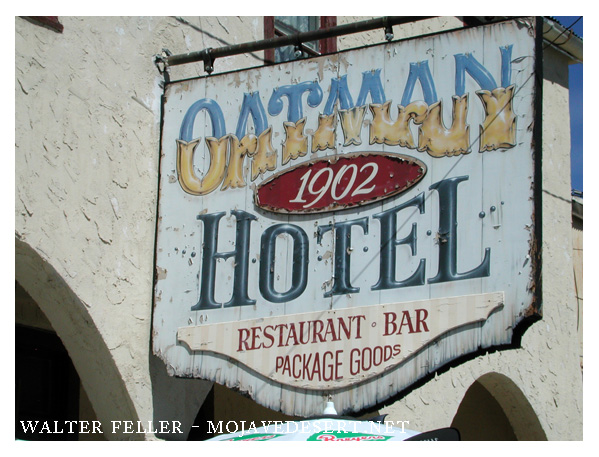Durlin (Oatman) Hotel

Located in beautiful and historic Oatman and named for its builder John Durlin, the Durlin Hotel is the only historic two-story adobe building in Mohave County. From its famous guests to its otherworldly inhabitants, the Durlin, known as the Oatman Hotel today, is a must stop for Route 66 travelers.
The namesake for the town of Oatman was Olive Oatman, a young Illinois woman kidnapped by Apache Indians and forced into slavery. The town of Oatman in the Black Mountains of Mohave County flourished soon after prospectors discovered gold worth $13 million dollars in 1908 and another gold mine in 1915 worth $14 million dollars. Oatmanís population ballooned to 3,500 within a year. In the 1920s and 30s, the population grew to around 10,000. In 1921, a fire swept through the town destroying most of Oatmanís buildings. Originally built in 1902, the Durlin Hotel was rebuilt in 1924 after the fire.
The eight-room hotel enjoyed a prosperous business with local miners. The walls and ceiling of the hotelís saloon are covered in one-dollar bills that are dated and signed, a practice that began with the miners, who searched for their dollar bill on the wall when they were short on cash to pay for their drinks.
Clark Gable and Carole Lombard stopped at the historic Durlin Hotel for their honeymoon after their wedding in Kingman, Arizona in 1939. Mr. Gable fell in love with the town and often returned to play poker with local miners. The Gable/Lombard honeymoon suite is one of the hotelís attractions, and the hotelís owners report that the pair loved the hotel so much they simply refused to leave. They claim their ghosts still occupy the building and are often heard whispering and laughing in empty rooms. The friendly poltergeist Oatie is known to occupy the hotel as well and is believed to be the ghost of William Ray Flour, an Irish miner who died behind the hotel. Other friendly spirits are said to inhabit the hotel, including playful ghosts in the saloon, who have been known to raise money off the bar and lift glasses into the air.
In 1924, United Eastern Mines, the townís major employer, permanently closed its operations in Oatman. By 1941, the U.S. Government ordered the shutdown of the townís remaining mining operations as part of the countryís war efforts. Miners were sent elsewhere to work in the extraction of more valuable wartime metals.
Oatman was fortunate because of its location on U.S. Highway 66, and local commerce shifted toward accommodating motorists traveling between Kingman, Arizona and Needles, California. From 1926 to 1952, the Mother Road coursed through the heart of town, sustaining a healthy tourism business. Interstate 40 bypassed Oatman in the early 1950s, however, leaving the town all but abandoned within a decade. Today, the community has only about 100 fulltime residents who primarily cater to tourists.
In the late 1960s, the Durlin Hotelís name was changed to the Oatman Hotel. The hotel no longer has overnight accommodations but still houses a bar and restaurant on the first floor and a museum on the upper floors. It was listed on the National Register of Historic Places in 1983.
Source - NPS